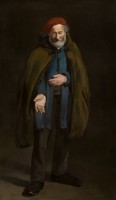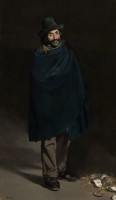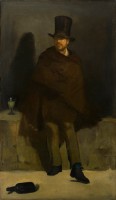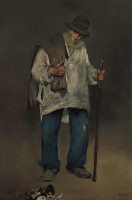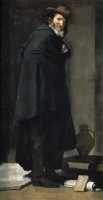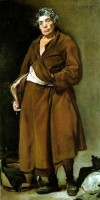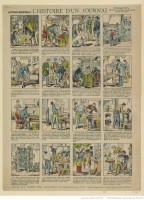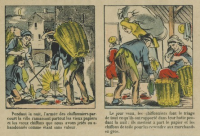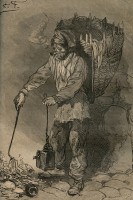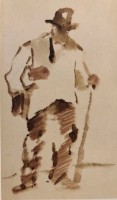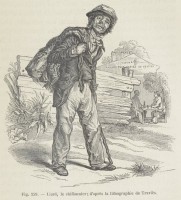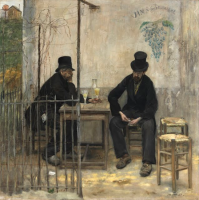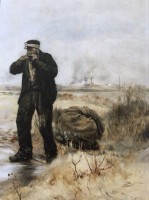The browser will either open the file, download it, or display a dialog.
In his records from 1872, Édouard Manet (1832–83) lists four portraits that depict figures from the margins of society as “four philosophers”: Beggar with Oysters (Philosopher), Beggar with a Duffle Coat (Philosopher), The Absinthe Drinker, and The Ragpicker (figs. 1–4).[1] Four Philosophers is also the title of a painting from 1611–12 by Peter Paul Rubens, which depicts Rubens himself, his brother Philip, humanist Justus Lipsius, and lawyer Joannes Woverius (fig. 5). Given Eugène Delacroix’s advice to Manet to “look at Rubens, draw inspiration from Rubens, copy Rubens. Rubens was God,”[2] we might consider Manet’s homage to the old master as part of a new perception of modernity in which the perceived essence of a philosopher assumes a new form. Indeed, many scholars have already suggested that in the nineteenth century contemporary figures such as beggars and ragpickers (chiffoniers) were regarded as philosophers of a kind, individuals who rejected the accepted norms of labor and challenged those of society.[3] This article focuses on one of Manet’s four philosophers, The Ragpicker (1865–70; fig. 4). This large-scale painting depicts an old man, with no details except for a pile of garbage at his feet, which he stares at diffidently from above. The work’s resemblance to the other three philosophers is clear from its format and composition, wherein a single male figure is imaged against a dark background. However, the main characteristic that differentiates The Ragpicker from the other three paintings is that he represents a working man in a legitimate profession. Unlike begging (and drinking absinthe), ragpicking in the nineteenth century was a regulated licensed profession and the authorities acknowledged that it contributed to the economy. Thus, in contrast to the other philosophers who consume (whether absinthe or other people’s money), the ragpicker might be considered a supplier.
Unlike the paintings of the other philosophers, The Ragpicker has never been the subject of much scholarly attention. It is generally only mentioned in reference to other contemporary works of art depicting ragpickers and other figures from the margins of society. Anne Coffin Hanson suggests that iconographically The Ragpicker, along with the other philosophers, was influenced by Menippus (fig. 6) and Aesop (fig. 7), works by Spanish master Diego Velázquez, and that Manet adapted these types to contemporary Paris. Velázquez’s influence is also apparent in the way in which Manet placed objects on the ground next to the figures.[4] Other interpretations suggest that The Ragpicker can be read as a critical observation regarding the French government’s failure in handling social problems and poverty during the Second Empire.[5] Yet this painting shows no sign of the dramatic gestures usually associated with poverty and misery, such as agony or despair, nor is there any kind of a narrative that would be required for such a purpose. Linda Nochlin even described it as “formally distanced, almost set in quotation marks.”[6] However, the two main characteristics that are most visible in this painting and have significant meaning in the context of contemporary France—namely the figure’s advanced age and his occupation—have been overlooked in academic research. Building on Hanson’s iconographic interpretation, I situate The Ragpicker in the context of modern Paris, where Manet lived and worked. Through a discussion of the cultural conditions in France from the 1840s to the 1880s, I offer a new reading of the work as standing at the crossroads of consumer culture and aging. By analyzing Manet’s painting and comparing it to other visual and textual representations of ragpickers, I interpret The Ragpicker’s symbolic representation and suggest that reading this painting alongside Charles Baudelaire’s poetic works shows Manet’s ragpicker in a new light that outlines affinities between the contemporary older population and superfluous commodities. Paralleling Baudelaire’s writings and Manet’s painting, I argue that the painting represents a reflection on the elderly’s social state in contemporary France.
The Golden Age of Ragpicking
After proclaiming the Second Empire in 1852, Napoléon III fostered prosperity and progress with a view toward preventing revolts and preserving his power. The building of an extensive railway system was a great boon to the economy; the transport of foodstuffs and other goods became easier and cheaper, which had a tremendous effect on the market. The increase in consumer demand between 1850 and 1870 is an indication of some of the results of the emperor’s policies.[7] This trend was noticeable everywhere. For example, food consumption changed and eating turned into more than a necessity. Instead of having to grow and produce everything themselves, farmers could now afford to purchase what they needed, specialize in local products, and sell those commodities across the country. With the increase in availability, the urban middle classes demanded new products and a wider variety in their diets. By the 1860s, luxury foods such as fresh oysters were being delivered regularly throughout the country and the capital’s restaurant scene was flourishing.[8]
It was also during the Second Empire that France became a fashion capital. Empress Eugénie’s public appearances in voluminous and adorned gowns, which she considered “political outfits,” along with her avowed love for Lyonnaise silk, set the tone for the period’s fashion and gave a boost to France’s fashion industry.[9] Women who could not afford her rich and luxurious style altered their already existing wardrobes to keep up with the latest trends, which in turn led wealthier women to adopt ever-newer styles in order to distinguish themselves. Department stores arose throughout the country and offered fashions in all price ranges, seasonal products, and new niche fashions for different target markets.[10] The appearance of fashion magazines, books, and advertisements further expanded both the fashion market and the paper industry. Two world exhibitions in the renovated city of Paris in 1855 and 1867 served as international public demonstrations of the country’s progress and affluence. However, despite the apparent prosperity, Napoléon’s promises to eradicate pauperism in the working classes remained unfulfilled, and many people, ragpickers among them, experienced all the splendor of the Second Empire from the other side, earning their livings from its surpluses.
Ragpicking in France can be traced back to the Middle Ages, but it was from the 1840s to the 1880s, alongside the increase in the urban population and consumption, that this profession reached its “golden age.”[11] These years were characterized by the fact that the industrial revolution had developed more rapidly than the chemical industry in the sense that the latter had yet to achieve full production of the required raw materials for the various industries, so recycling existing products was essential.[12] Rags and animal bones provided the main sources of income for ragpickers, but as the rise in the demand for different raw materials increased in the 1860s, the variety of items collected grew. Following the introduction of new paper machines in the 1820s, which enabled the production paper in continuous rolls instead of by the sheet, there was a sharp increase in paper manufacture in France. Production numbers went from 25,000 tons of paper in 1830 to 50,000 tons in 1850, and reached 137,000 tons in 1873.[13] Paper was used not only in printing, but also for other purposes, such as the decorative paper flowers that were popular in bourgeois homes and the carton used in furniture. The production process was based on cloth (chiffon), and 1 kg of paper required 5 kg of rags. Animal bones were used to manufacture dominoes, buttons, door handles, tallow, and milliner’s glue. They were also the source for bone char, which was mainly used for refining sugar, the consumption (and production) of which increased in those years.[14]
Like animals at the bottom of the food chain who feed from carcasses and remains, ragpickers hunted for garbage and debris, picking up everything they could find in order to sell it back to the various industries for recycling. Everything was valuable: in addition to rags, paper, and animal bones, broken glass could be melted and reused; old wine corks were sold to wine makers; dead animals were valued for their skin and fur; and even human hair was sorted by color and sold to wig makers. However, toward the turn of the century, the numbers of ragpickers decreased as a result of the Poubelle ordinances of 1883 and 1884 (named after its initiator, Eugène Poubelle), which restricted such activities, and the fact that incineration plants began to reduce the quantity of disposed material.[15] Further, the chemical industry was finally introducing new materials that were cheaper to produce. Wood replaced cloth pulp in paper manufacture, celluloid replaced bones for many uses, and ragpicking, which became less and less profitable, was gradually abandoned.
The authorities saw ragpicking as a nuisance that had to be monitored, so ragpickers had to obtain an official license in the form of a medal, which they had to carry with them. However, whereas records indicate that 5,952 registered ragpickers were working in Paris in 1875, estimates suggest that in reality there were around 30,000 to 40,000.[16] Yet, as previously mentioned, in the economic realm, ragpickers’ work was encouraged, as they supplied a significant part of the raw material required by industry, as evident from an 1862 municipal document that stated: “This industry, which is repulsive, must be encouraged because of the useful products it gives to the manufacturing of paper, cardboard, bone char: The (annual) revenue of this industry can be evaluated without a doubt at 1,500,000 fr.”[17] Furthermore, sanitary services were poor in those days, and ragpickers’ activity removed at least some of the urban refuse that was thrown into the street. An example of this can be found in a page from the illustrated encyclopedia Glucq (Série encyclopédique Glucq des leçons de choses illustrées; Glucq encyclopedic series of illustrated practical lessons) from 1882 (fig. 8), which describes newspapers’ production process. The ragpickers, men, women, and children, are shown with their equipment in the first two illustrations: a lantern, a sack or basket, and a stick, usually with a hook at one end (fig. 9). They are dressed in rags, working at night looking for scraps of paper and cloth in the rubbish in the street. The second illustration depicts a morning scene and shows the ragpickers sorting everything they had collected at night and preparing it for sale to the paper traders.
As evident from the illustration, men and women of all ages worked as ragpickers. Nevertheless, Manet’s ragpicker depicts an aged man: he has a big, messy white beard, stains of color around his eyes that give the impression of an old man’s features, and he seems slightly bent. Nochlin observed that in the context of the nineteenth-century industrial revolution, capitalism, and the lives of the working classes, the figure of the old man, let alone the poor old man, was a signifier of misery.[18] Yet, in the case of The Ragpicker, I consider the figure’s age to reference another aspect of modern life. Along with consumerism, an increase in the aging population also had an impact on contemporary France.
Aging in France
During the nineteenth century, the country underwent a significant demographic change and became the “oldest” country in Europe. The percentage of men and women over the age of sixty rose from 8.5 to 12.5 percent, an increase of more than one million people. In the 1860s, as throughout the century, life expectancy at birth was relatively low in comparison with today, averaging around forty-two years, owing primarily to the high percentage of child mortality in this period: one in five children did not survive his/her fourth birthday.[19] However, after the age of fourteen, life expectancy increased, so at the age of sixty-five, men and women might live eleven years more, and at eighty around five years.[20] Concluding “who is old” is a social construct no less than a biological one, and in the nineteenth century the age of fifty was generally the threshold to old age, with variations that depended on class and gender. In general, women “aged” earlier than men, although biologically the opposite was true.[21] This demographic trend was noticeable at all levels of society and, according to historian Peter Stearns, the proportion of elderly in the population was definitely prominent.[22] Scholars often consider aging populations as a symptom of modernity, as it implies that the rise in life expectancy is an outcome of advanced medical and technological knowledge. Although life expectancy in France did increase during this period, the main reason for the greater percentage of older people in the population was the declining birth rate.[23] However, these two demographic factors both lead to the same outcome—a smaller percentage of the younger population in comparison to the increasing older population. Inevitably, such a condition, in which the aging population is growing faster than the younger one, has economic and social implications, which, for the first time, had to be addressed. Thus, I regard the aging of the French population during this period as an aspect of modern life. But France was not prepared to deal with this new reality, which primarily affected the lower classes: reaching the age of sixty with more than ten years to live, and with neither pensions nor adequate welfare systems available for all, the working-class elderly were doomed to eventual poverty.[24] Hospices, mutual aid societies, and charity offices (bureaux de bienfaisance) offered some aid, yet it is difficult to assess its nature and the degree of help provided by these bodies, as well as the percentage of those who applied for it.[25] Some elderly turned to their families for help or moved in with their children, who did not always welcome them. Émile Zola described such a situation in La Terre (The Soil; 1888), summarizing it in a dreadful way:
Old folk, in a like way, are good for nothing, and are only a source of expense, so the sooner they are out of the way the better. He himself had wished for his father’s death; and now if his children, in their turn, impatiently awaited his own, it neither surprised nor hurt him.[26]
Financial agreements such as donations entre vifs (living inheritances) were signed, typically with the expectation of something in return. In practice, this meant that the elderly parents would give up their land or possessions in return for a pension on which they could live.[27] Other elderly had to search for an income in any way they could and often took up begging or ragpicking.
The Ragpicker embodies both of these aspects—mass consumption and old age. Here we see an old man whose job is to gather the discards of consumerism. Attributes such as the rubbish at his feet, the stick in his hand, and the sack on his shoulder testify to his profession as a ragpicker. Unlike Manet’s three other “philosophers,” who are relatively well dressed and wear either a coat or a cloak, this figure is clothed in torn and dirty rags, reflections of the refuse he collects: his shirt, which was intended to be worn under a vest or a jacket and used to be white, hangs out over his torn trousers and his hands are stained. The resemblance between the ragpicker and the debris he collected was common in the nineteenth century. Whereas contemporary visual representations depict ragpickers dressed in rags, some go even further and represent them in the same manner as the rags they collect, as in an illustration published in 1884 (fig. 10). Here, the man’s pants appear patched up with pieces of fabric (chiffons) in different patterns. The texture of his clothes echoes the rags he is collecting with his hook, as well as those that are hanging out of the basket on his back. Furthermore, a closer look at the ragpicker’s face reveals the same technique. His cheekbones, eyebrows, and the lower part of his nose appear to reflect the light shining from the lantern below, giving the impression that they were attached to his face in a patchwork. Moreover, his beard seems to have the same texture as the rags that make up his clothing, the same rags he collects. All of these features give the impression that he himself is literally a “rag man.”
This resemblance between the ragpicker and the debris he collects is also apparent in textual representations. One example can be found in Les Français peints par eux-mêmes (The French painted by themselves), a series of literary and graphic sketches from the early 1840s describing social and professional types. Les Français is attributed to the “physiologies” literary genre, which was popular among urban bourgeois society and was often based on stereotypes that may have reflected the dominant view. The entry about the ragpickers in Les Français was written by Louis-Agathe Berthaud and presents them as monstrous, ignoble, and filthy. He describes their homes as dirty and filled with rubbish of all sorts, and lists the items of waste that could be found there, from pieces of bread to corpses of cats and dogs. Among these repellent objects, Berthaud mentions the French word chiffonnier, which can also refer to a chest of drawers, but here is clearly alluding to the ragpicker. Hence, not only are they surrounded by debris as part of their profession, but their whole existence reflects the rubbish they collect and thus the excess of consumerism.[28]
A Ragpicker Unlike the Others
However, whereas many artists were familiar with the physiologies genre and often referenced the types and representations described there, Manet’s The Ragpicker seems somewhat detached from the filth that Berthaud and his contemporaries described.[29] The painting shows a minimum of details, and as Antoine Compagnon notes, the ragpicker looks sanitized, and we cannot sense the smells of Paris from this representation. Compagnon observes that the ragpicker’s hook is reduced to a simple stick, the basket is an empty knapsack, and the rubbish is depicted with the aesthetics of a still-life painting.[30] Not only is this pile of rubbish small, but the whole surface around it is tidy and clean. I suggest reading this minimalism as a profound contrast to the excessive consumption that is reflected in the atypical rubbish. Manet did not picture any rags or papers, but only luxury items, including a broken bottle of champagne, some oyster shells, and the peel of a banana—an exotic imported fruit. Furthermore, the marginal position of the rubbish in the composition and the fact that it is cut by the edge of the canvas might imply that it was added after the ragpicker’s figure was completed. Accordingly, the pile of rubbish is missing from the watercolor study Manet did for this painting (fig. 11).
Indeed, when one compares Manet’s ragpicker to other such representations, both textual and visual, one notes that he lacks the realistic features that would associate him with descriptions of filth and scum. This old man does not seem to fit the stereotypes of a contemporary chiffonnier: “proud, because he believes he is free,”[31] “work less, drink as much as possible,”[32] or speak “slang, the language of thieves and murderers,”[33] which perhaps are more suitable for Charles-Joseph Traviès de Villers’s proud and content looking chiffonnier (fig. 12), created about thirty years earlier and widely reproduced in the following decades. Based on the character of a famous ragpicker from the 1830s named Liard, Traviès de Villers’s ragpicker may seem slightly bent, but nevertheless he stands steadily with his legs spread and looks at the viewer. His hat covers his head down to his eyebrows, and the fact that we can see his eyes indicates that he is lifting his head, as if looking down at us, proudly and confidently. On his far left are two figures sitting next to a table in what Marnin Young notes is a scene similar to that of The Absinthe Drinkers (1881; fig. 13) by Jean-François Raffaëlli (1850–1924).[34] According to Young, this correspondence suggests a link between ragpickers and suburban cafés and drinking. Thus, while not strictly a caricature, this lithograph by Traviès de Villers nevertheless reflects some of the widespread notions about ragpickers that we do not see in Manet’s The Ragpicker.
Another motif that is missing from Manet’s painting is any kind of narrative that links it to the daily lives of ragpickers, as is apparent in other works. Ragpickers and their habitual surroundings were a prominent theme in Raffaëlli’s art between 1879 and 1884, the years when their numbers were starting to decrease. As an artist who observed and studied his subjects very carefully, Raffaëlli depicted ragpickers in realistic scenes and in spontaneous moments.[35] He situated them in their “natural” settings at the outskirts of Paris, in an area that was known as Le Zone—outside the city but not exactly the countryside—where ragpickers lived and sorted their findings. In Ragpicker Lighting His Pipe (1879; fig. 14), painted some fifteen years after Manet’s work, Raffaëlli represents a ragpicker during a smoking break, concentrating on preparing his pipe, while his big, heavy-looking bag lies full on the ground behind him. Here, for example, the desolate open landscape and the smoking chimneys indicate the location of the scene—the suburbs of the city—and judging by the vegetation and the ragpicker’s layered clothing and coat, it is probably an autumn day. All of these details render this ragpicker a realistic representation, and the whole scene offers a sense of a narrative that the viewer can complete on his or her own. One can imagine, for example, that after the ragpicker finishes lighting his pipe, he will take a few puffs, lift his heavy sack on his back, and carry on with his wanderings or head on to unpack his treasures.
In contrast, Manet’s ragpicker looks rather mysterious and there are no obvious details that can help the viewer interpret the painting. The space in which he is represented, which is missing a clear source of light, a surface plane, and details, is not identified. One cannot determine whether the figure is situated in an open setting or in some kind of an interior, or even the time of the day. These are, of course, features of Manet’s modernism, in which the flatness and lack of the spatial context gives way to a focus on the pictorial context, that is, the painting being a painting.[36] But even within the framework of modernity, this painting is different not only from other representations of ragpickers, but also from the three other figures that make up Manet’s four philosophers. The two beggars and the absinthe drinker clearly cast shadows, emphasizing their existence and declaring their presence in space. But the ragpicker does not cast a shadow, suggesting that he is someone who does not exist and who is unnoticeable and of no importance. It seems as if Manet tore him from his natural context and placed him into the guise of a ghost who has no reflection in a mirror. The shadows of the other three philosophers fall in the same direction, implying the same source of light—presumably an artificial one, such as a gas lamp in the artist’s studio, which might simulate a streetlight. Yet, the manner in which the background is painted and surrounds the ragpicker, with nuances of bright color covering the dominant brownish-gray surface, gives the misty impression of a fog or a haze, like a dream in which the ragpicker is revealed to us.[37] Instead of reaching out to the pile of rubbish next to him, he examines it from afar, as if he is reluctant to touch it. Moreover, although this painting might be considered a portrait, the ragpicker’s face is not in focus, but rather it is hidden under his hat and his long, unkept white beard. His eyes are obscured and shadowed, bringing to mind early self-portraits by Rembrandt.[38] H. Perry Chapman suggests that Rembrandt used such shadowing around the eyes to depict melancholy, a characteristic that since the days of Aristotle was attributed to great intellectuals, such as philosophers.[39] By representing the ragpicker in this manner, along with other puzzling details, Manet managed to achieve an enigmatic and intriguing figure.
As evident in both Les Français and Traviès de Villers’s lithograph, both of which date to the 1830s and 1840s, and Raffaëlli’s ragpickers, dated to the 1880s, the figure of the ragpicker was prominent throughout the nineteenth century. Whereas in the earlier decades he was seen as a romantic figure, a philosopher who was free of daily materialistic worries, in Raffaëlli’s art he was portrayed with more realism as a man whose profession is gradually waning. Yet, Manet’s ragpicker came during the time of the economic growth of the Second Empire and thus the heyday of ragpicking. Indeed, the characteristics evident in The Ragpicker are unlike those in the other representations and the common stereotypes of ragpickers. Surely, Manet’s painting calls for a symbolic interpretation rather than a realistic one. But what does it symbolize? I suggest that reading this painting alongside Baudelaire’s writings, which, as I show below, refer to the same unclear characteristics, alludes to the shameful attitude toward the elderly poor during that time. Although the parallels between Baudelaire’s words and Manet’s art have been widely discussed, there has never been any indication of an association with The Ragpicker.[40] Furthermore, the fact that Baudelaire died in 1867, during the time that Manet was working on this painting, might account for the resemblance to the Baudelairean chiffonnier.
Manet’s Ragpicker and the Baudelairean Chiffonnier
The figure of the ragpicker serves as an example of Baudelaire’s “heroism of modern life.” This is a “private subject,” a figure who drifts about in the subterranean world of the great city, a figure that Baudelaire saw as no less heroic than the public political ones.[41] He is eternal—as are the objects he gives life to by saving and recycling—yet transitory, as he never stays in one place, endlessly vagabonding when night falls in search of those objects. But Baudelaire’s preoccupation with ragpickers went further, as he wrote elaborately about their daily work and life in several places, comparing them to sensitive poets. This comparison is clearly made in “Le Vin des chiffonniers” (The Ragpicker’s Wine) published in Les Fleurs du mal (The Flowers of Evil), where the ragpicker is “stumbling, bumping against the walls like a poet.”[42] Here, Baudelaire described the miserable lives of the ragpickers, who are distorted by work and age, and cast out of Parisian society. He writes about the “vomit of Paris” in such an ambiguous way that it could refer to the urban refuse that the ragpickers collected, but also to the ragpickers themselves, thus pointing to the resemblance between the two. But in contrast to the same analogy made in Les Français, here the common ground for the comparison is the big city, which rejects the ragpickers in the same way that it rejects useless objects and refuse. Manet related to both these “rejectees” in his painting and portrayed them in “nowhere,” alone and excluded from the modern city and its society, just as Baudelaire describes them:
Yes, these people harassed by domestic worries,
Ground down by their work, distorted by age,
Worn-out, and bending beneath a load of debris,
The commingled vomit of enormous Paris.[43]
In “Du vin et du hachisch” (On Wine and Hashish), Baudelaire elaborates the notions introduced in “Le Vin des chiffonniers” and invites his readers to think about the ragpickers, whom he calls “mysterious beings.” He goes on to describe their hard and dirty work, searching the city for everything that it had rejected, broken, and disdained, and the means by which it was transformed it into something new and useful, giving it a second chance.[44] The whole scene is set in the dim light of the street lamps, disturbed only by the night wind, similar to the obscured hazy setting in Manet’s painting.[45] Baudelaire’s ragpicker nods his head and stumbles on the pavement, like a young poet wandering around all day in search of rhymes.[46] Significantly, in “Le Soleil” (The Sun) Baudelaire perceives the poet’s quest for words as the ragpicker’s hunt for debris.[47] The poet’s symbolic struggle using the image of a fence echoes the ragpicker’s hook:
I walk alone, absorbed in my fantastic play,
Fencing with rhymes, which, parrying nimbly, back away;
Tripping on words, as on rough paving in the street,
Or bumping into verses I long had dreamed to meet.[48]
Baudelaire addresses the city, his inspiration as a poet, and declares: “You gave me your mud and I have turned it into gold,”[49] a description that could also have been applied to ragpickers, who saw value in the city’s debris and were the agents through which it was recycled into desirable objects. Both the poet and the ragpicker are fed by the big city. Just like the poet, who sensitively chooses his words, Baudelaire describes the ragpickers as sensible figures, who make intelligent decisions while carefully collecting, sorting, and cataloging potential debris.[50] However, in reality, ragpickers did not, as Baudelaire suggests, have the time to contemplate every object they encountered. They had to work fast and move quickly from one spot to another in order to reach as many valuable objects as possible ahead of their competitors. Nevertheless, Manet’s ragpicker does seem to linger and reflect upon the garbage at his feet, similar to Baudelaire’s description. His calm and focused expression suggests that he is in the process of carefully evaluating it.
In the second “Spleen,” also from Les Fleurs du mal, Baudelaire writes about the great load of memories that are stored in his head, greater even than the number of objects that can fit in a big piece of furniture with drawers (which, although not mentioned explicitly, brings to mind a chiffonnier). He goes on and compares himself to an ancient boudoir. Yet, all the items that are buried within him, which symbolize his memories, are useless and of no interest to anyone. The metaphors he uses for these memories are old objects that have gone out of fashion and have lost their appeal, their shine, and their value: obsolete fashion, faded pastels, and pale paintings by François Boucher. It has been suggested that these metaphors are a response to the industrial revolution, during which everything changed so rapidly that all intimate and sentimental relationships with objects were dissolved.[51] However, all these objects illustrated positive and nostalgic events from the past. Similarly, the items of rubbish that Manet depicts in The Ragpicker—a bottle of champagne, oyster shells, and bananas—also refer to a celebration or a joyful feast that took place some time ago. Ultimately what is left of Baudelaire’s memories, as well as of Manet’s feast, are things that one usually discards, disposable objects that no longer function or are of any use—objects that are the ragpickers’ interest:
I am an old boudoir full of withered roses,
Where lies a whole litter of old-fashioned dresses,
Where the plaintive pastels and the pale Bouchers,
Alone, breathe in the fragrance from an opened phial.[52]
Baudelaire’s “Spleen,” then, implies that memories have neither place nor meaning in a rapidly changing modern world. They are discarded in the same way as dispensable objects, old fashions, and withered roses.
The association of memories and old age is suggested at the beginning of “Spleen”: “I have more memories than if I’d lived a thousand years.”[53] Hence, as one gets old one collects many memories, but as Baudelaire reveals later on, they are neither of use nor of interest to anyone. Thus, in the same way that old and useless objects are discarded, old people, who have a lifetime of memories that are no longer useful or of interest, are disregarded. Manet represents the ragpicker as an aged man, alone, whereas the rubbish next to him symbolizes the memories he collected over the years. Both the rubbish and the memories are reminiscent of something that no longer exists. Rejected by society like a useless object, Manet’s ragpicker is an outcast because of his profession, but also because of his relatively “excessive” age.
Conclusion
Although traditional painting from the past was used for the perpetuation of great men, as was in the case of Rubens’s Four Philosophers, Baudelaire called for modern painting to perpetuate the ordinary. The modernity of Manet’s The Ragpicker is reflected not only in its subject, but also in its lack of detail and background, which emphasizes its pictorial character. These, in addition to the figure’s odd posture opposite the rubbish on the floor, strip this painting of any realistic or stereotypic connotations to contemporary ragpickers. At the same time, the combination of an aged figure and the profession of ragpicking embeds a complex view of contemporary France in Manet’s time. As a ragpicker, this individual is cast out of society and is relegated to its margins, an echo of the urban refuse he collects in the streets. Moreover, as an old man, he is neglected by the country as a result of a poor welfare system and ignored by society itself, like its residue. Similarly, Baudelaire associates the aftermath of consumerism with old age, observing that useless objects that are no longer of any interest resemble the memories one collects in a lifetime. Like commodities, these memories, once a vivid and colorful reality, fade over time and become useless. Thus, I consider Manet’s painting a social commentary on two aspects of contemporary life that reached their peaks in the 1860s: consumerism and old age. In a society that sanctified consumerism, owing to the ragpicker’s work, old objects became useful again, whereas old people were marginalized and forgotten. Nevertheless, in this painting, Manet also exposes his own ragpicker qualities and even becomes one himself: in his “collecting” old people on the streets who were regarded as no longer serving any use, “re-contextualizing” them, and giving them a new role in modern painting.
I am deeply grateful to Prof. Ruth E. Iskin and Dr. Ronit Milano, who guided my research throughout, and also to Prof. Petra ten-Doesschate Chu and the anonymous reviewer for their insightful comments and suggestions. All translations are my own unless otherwise indicated.
[1] Anne Coffin Hanson, Manet and the Modern Tradition (New Haven, CT: Yale University Press, 1979), 65.
[2] Gary Tinterow et al., Masterpieces of European Painting, 1800–1920, in the Metropolitan Museum of Art (New York: Metropolitan Museum of Art, 2007), 92.
[3] See, for example, Antoine Compagnon, Les Chiffonniers de Paris (Paris: Gallimard, 2017); Marilyn R. Brown, “Naturalist Bohemians: 1860–1871,” in Gypsies and Other Bohemians: The Myth of the Artist in Nineteenth-Century France (Ann Arbor, MI: UMI Research Press, 1985), 73–92; and Marnin Young, “Heroic Indolence: Realism and the Politics of Time in Raffaëlli’s Absinthe Drinkers,” The Art Bulletin 90, no. 2 (June 2008): 251–52.
[4] Anne Coffin Hanson, “Manet’s Subject Matter and a Source of Popular Imagery,” Art Institute of Chicago Museum Studies 3 (1968): 72, 74.
[5] Gabriel P. Weisberg, “The Traditional Realism of François Bonvin,” The Bulletin of the Cleveland Museum of Art 65, no. 9 (November 1978): 287.
[6] Linda Nochlin, Misère: The Visual Representation of Misery in the 19th Century (London: Thames and Hudson, 2018), 135–36.
[7] Roger Price, The French Second Empire: An Anatomy of Political Power (Cambridge: Cambridge University Press, 2001), 212.
[8] Anne Green, Changing France: Literature and Material Culture in the Second Empire (New York: Anthem Press, 2011), 65–90.
[9] Green, Changing France, 117.
[10] Some of the notable department stores that opened during the time of the Second Empire were Le Bon Marché (1852), Les Grands Magasins du Louvre (1855), Bazar de l’Hôtel de Ville (1860), Le Printemps (1865), and Magasins Réunis (1866). On consumerism and fashion in impressionist painting, see Ruth E. Iskin, Modern Women and Parisian Consumer Culture in Impressionist Painting (Cambridge: Cambridge University Press, 2007).
[11] Sabine Barles, L’Invention des déchets urbains: France 1790–1970 (Seyssel, France: Champ Vallon, 2005), 53; Compagnon, Les Chiffonniers de Paris, 9.
[12] Compagnon, Les Chiffonniers de Paris, 16.
[13] In 1827 there were four paper factories that produced paper in rolls, at least twelve in 1834, and 201 in 1851. Barles, L’Invention des déchets, 28.
[14] Sugar consumption in France increased from 3.5 to 5 kg per capita per year between 1836 and 1856, with the exception of Paris with 11 kg per capita per year in the 1850s. Production followed the demand, with 260,000 tons in 1858 and 440,000 tons in 1897. Barles, L’Invention des déchets, 42, 50.
[15] As the regional administrator of the Seine Department (préfet de la Seine), Poubelle published two orders in 1883 and in 1884 that prohibited throwing garbage in the streets. All the waste was to be put in specific bins, and the building’s concierge was responsible for placing them in the street for disposal at a specific hour. This, along with the restriction on ragpickers from spilling garbage in public ways—necessary for looking through it—had a massive effect on ragpicking in France. The French word for trash bin, la poubelle, is named after its initiator. Barles, L’Invention des déchets urbains, 167.
[16] Compagnon, Les Chiffonniers de Paris, 14.
[17] “Cette industrie, dont le mode est repoussant, doit être encouragée à cause des produits utiles qu’elle donne à la fabrication du papier, du carton, du noir animal: le revenu de cette industrie peut être évalué sans crainte d’erreur à 1.500.000 fr.” In Barles, L’Invention des déchets urbains, 65. Given that in 1850 the average daily salary was around two and a half to four francs, 1,500,000 francs can be very roughly estimated today as 50,000,000 to 100,000,000 euros.
[18] Nochlin, Misère, 22, 152.
[19] France Meslé and Jacques Vallin, “Reconstitution de tables annuelles de mortalité pour la France au XIXe siècle,” Population 44, no. 6 (November–December, 1989): 1136. On the influence of child mortality on life expectancy in Europe in the nineteenth century, see Thierry Eggerickx, Jean-François Léger, Jean-Paul Sanderson, and Christophe Vandeschrick, “L’Évolution de la mortalité en Europe du 19e siècle à nos jours,” Espace populations sociétés (March 2017), http://journals.openedition.org/eps/7314, doi:10.4000/eps.7314.
[20] Peter Stearns, Old Age in European Society: The Case of France (New York: Holmes and Meir, 1976), 14–15; Jérôme Bourdieu, Lionel Kesztenbaum, and Madeleine Grieve, “Surviving Old Age in an Ageing World: Old People in France, 1820–1940,” Population 62, no. 2 (2007): 183. The percentages vary slightly from one study to another, but all of them point to approximately the same numbers and that France became the first country in Europe to experience an aging population.
[21] Peter S. Stearns, “Old Women: Some Historical Observations,” Journal of Family History 5, no. 1 (Spring 1980): 45–46; Bourdieu et al., “Surviving Old Age in an Aeging World,” 185; Erna Olafson Hellerstein, Leslie Parker Hume, and Karen M. Offen, Victorian Women: An Account of Women’s Lives in Nineteenth-Century England, France, and the United States (Stanford, CA: Stanford University Press, 1981), 452–53.
[22] Stearns, Old Age, 19.
[23] Bourdieu et al., “Surviving Old Age in an Ageing World,” 185–86.
[24] Bourdieu et al., “Surviving Old Age in an Ageing World,” 183, 202; Stearns, Old Age, 15. Some companies and government institutions did provide pensions to their workers, yet it was not until 1910 that a national pension plan was inaugurated. Philip Nord, “The Welfare State in France, 1870–1914,” French Historical Studies 18, no. 3 (Spring, 1994): 821–38.
[25] Bourdieu et al., “Surviving Old Age in an Ageing World,” 202–3. In the days of the Second Empire, mutual aid societies were regarded as “dangerous” opposing organizations. See Price, The French Second Empire, 208–9, 331–32.
[26] Émile Zola, The Soil (La Terre) (London: Vizetelly and Co., 1888), 384.
[27] Andrew J. Counter, Inheritance in Nineteenth-Century French Culture: Wealth, Knowledge and the Family (London: Legenda, 2010), 160.
[28] Emma M. Bielecki has noted this detail in “‘Un Artiste en matière de chiffons’: The Rag-Picker as a Figure for the Artist in Champfleury’s ‘La Mascarade de la vie parisiene,’” Nineteenth-Century French Studies 37, no. 3/4 (Spring/Summer 2009): 264–65.
[29] For example, see Lauren S. Weingarden’s discussion on the references made by Courbet to the physiologies genre and, in particular, to Les Français peints par eux-mêmes, which she discusses at length: Lauren S. Weingarden, “Imaging and Imagining the French Peasant: Gustave Courbet and Rural Physiologies,” Nineteenth-Century Art Worldwide 12, no. 1 (Spring 2013), http://www.19thc-artworldwide.org/spring13/weingarden-imaging-and-imagining-the-french-peasant; and “Manet’s Subject Matter and a Source of Popular Imagery,” 65–66.
[30] Compagnon, Les Chiffonniers de Paris, 256.
[31] “fier parce qu’il se croit libre,” Émile de la Bédollière, “Le Chiffonnier,” in Les Industriels: Métiers et professions en France (Paris: Librairie de Louis Janet, 1842), 170.
[32] “travailler le moins, boire le plus possible,” Bédollière, “Le Chiffonnier,” 174.
[33] “l’argot, l’idiome des voleurs et des assassins,” Louis-Auguste Berthaud, “Les Chiffonniers,” in Les Français peints par eux-mêmes, ed. Léon Crumer, vol. 3 (Paris: Huart, 1841), 334.
[34] Young, “Heroic Indulgence,” 251.
[35] Young, “Heroic Indulgence,” 237, 252.
[36] Michael Fried, Manet’s Modernism: Or the Face of Painting in the 1860s (Chicago: University of Chicago Press, 1996), 14–18.
[37] Nancy Locke writes about what she describes as an “oceanic” background in Manet’s Beggar with Oysters (Philosopher). She notes that it is “not a simple absence, it is palpable, it is felt, it holds its own next to the figure.” Nancy Locke, “Manet’s Oceanic Feeling,” Nineteenth-Century Art Worldwide 4, no. 1 (Spring 2005), http://www.19thc-artworldwide.org/spring05/manets-oceanic-feeling. This background evokes The Ragpicker’s setting, though they are not similar: The Philosopher casts a shadow behind him and the background is slightly darker than in The Ragpicker.
[38] Antonin Proust (1832–1905) commented on Manet’s admiration of Rembrandt, which is considered a source of inspiration for some of Manet’s paintings. Gary Tinterow and Geneviève Lacambre et al., Manet/Velázquez: The French Taste for Spanish Painting (New York: The Metropolitan Museum of Art, 2003), 204; Michael Fried, Manet’s Modernism, 107–9.
[39] H. Perry Chapman, “Expression, Temperament and Imagination in Rembrandt’s Earliest Self-Portraits,” Art History 12, no. 2 (June 1989): 158–75.
[40] A selected bibliography on the parallels between Manet’s art and Baudelaire’s writing: Hanson, Manet and the Modern Tradition, 36–43, 65–66; Nancy Locke, “Unfinished Homage: Manet’s Burial and Baudelaire,” The Art Bulletin 82, no. 1 (2000): 68; J. A. Hiddleston, “Baudelaire, Manet and Modernity,” The Modern Language Review 87, no. 3 (July 1992): 567–75; Ewa Lajer-Burcharth, “Modernity and the Condition of Disguise: Manet’s ‘Absinthe Drinker,’” Art Journal 45, no. 1 (Spring 1985): 18–26; Katherine Golsan, “The Beholder as Flâneur: Structures of Perception in Baudelaire and Manet,” French Forum 21, no. 2 (May 1996): 165–86; and Michael Fried, “Painting Memories: On the Containment of the Past in Baudelaire and Manet,” Critical Inquiry 10, no. 3 (March 1984): 510–42.
[41] Charles Baudelaire, “Salon de 1846,” in Œuvres complètes, ed. Claude Pichois (Paris: Gallimard, 1975/76), 1:493–96.
[42] “Butant, et se cognant aux murs comme un poète,” Charles Baudelaire, “Le Vin des chiffonniers,” in Œuvres complètes, 1:106; translation from William Aggeler in The Flowers of Evil (Fresno, CA: Academy Library Guild, 1954), https://fleursdumal.org/poem/193.
[43] “Oui, ces gens harcelés de chagrins de ménage, / Moulus par le travail et tourmentés par l’âge, / Éreintés et pliant sous un tas de débris, / Vomissement confus de l’énorme Paris.” Baudelaire, “Le Vin des chiffonniers,” 1:106; translation from Aggeler, The Flowers of Evil, https://fleursdumal.org/poem/193.
[44] Charles Baudelaire, “Du vin et du haschisch,” in Œuvres complètes, 1:381.
[45] “Le voici qui, à la clarté sombre des réverbères tourmenté par le vent de la nuit,” Baudelaire, “Du vin et du haschisch,” 1:381.
[46] “Il arrive hochant la tête et butant sur les pavés, comme les jeunes poètes qui passent toutes leurs journées à errer et chercher des rimes,” Baudelaire, “Du vin et du haschisch,” 1:381.
[47] Debarati Sanyal, The Violence of Modernity: Baudelaire, Irony and the Politics of Form (Baltimore, MD: The John Hopkins University Press, 2006), 62.
[48] “Je vais m’exercer seul à ma fantasque escrime, / Flairant dans tous les coins les hasards de la rime, / Trébuchant sur les mots comme sur les pavés / Heurtant parfois des vers depuis longtemps rêvés.” Charles Baudelaire, “Le Soliel,” in Œuvres complètes, 1:83; translation from Edna St. Vincent Millay, Flowers of Evil (New York: Harper and Brothers, 1936), https://fleursdumal.org/poem/101.
[49] “Tu m’as donné ta boue et j’en ai fait de l’or,” Charles Baudelaire, epilogue for 2nd edition of Les Fleurs du Mal, 1861, in Œuvres complètes, 1:192.
[50] Baudelaire, “Du vin et du haschisch,” 1:381.
[51] Compagnon, Les Chiffonniers de Paris, 18.
[52] “Je suis un vieux boudoir plein de roses fanées, / Où gît tout un fouillis de modes surannées, / Où les pastels plaintifs et les pâles Boucher, / Seuls, respirent l’odeur d’un flacon débouché.” Charles Baudelaire, “Spleen,” in Œuvres complètes, 1:73; translation from Aggeler, The Flowers of Evil, https://fleursdumal.org/poem/159.
[53] “J’ai plus de souvenirs que si j’avais mille ans.” Baudelaire, “Spleen,” 1:73; translation from Aggeler, The Flowers of Evil, https://fleursdumal.org/poem/159.


